Cosmic Curiosities
“I was star-struck at age nine. Having been born in the Bronx, I thought I knew how many stars there were in the night sky, about a dozen. Then you go into the dome of the planetarium and then thousands of stars come out. I just thought it was a hoax.”
~ Neil de Grasse Tyson, American Astronomer
Getting Close to Mars
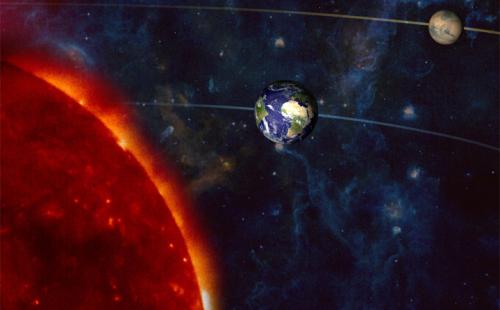
Back in August 2003, it truly was Mars mania. For a brief time during the pre-dawn hours on August 27, the red planet was closer to Earth than it had been in 60,000 years! Many Mars-watching events were held by groups such as planetariums, parks, museums, and astronomy clubs. Back then, I was working in Minneapolis. We had over 5,000 people descend upon our celestial gathering -- at five o’clock in the morning!
The upcoming 2018 Mars wave may not be as wild, but the red planet will still shine brighter than it has since those August nights 15 years ago. Every 2.2 years, Mars lines up with Earth on the same side of the Sun. This planet proximity is not always the same because their orbits are not perfect circles but elliptical. This year on July 31, Mars and Earth will be 35.8 million miles apart. In 2003, the two rocky worlds were 34.6 million miles away from each other. It won’t be until September 11, 2035 when Mars is closer to the Earth than this late July!
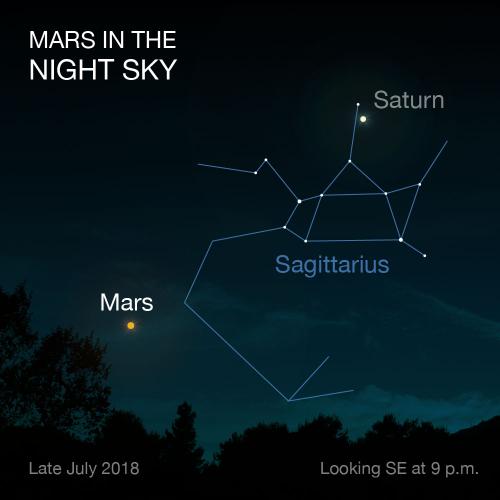 To see a blazing, red-orange Mars in the sky, look low in the south any time of night in late July or early August. On July 27, it will be at opposition, rising at sunset in the southeast and setting in the southwest at sunrise. It will be located in the constellation of Sagittarius, the centaur—which is often called the “teapot.” By mid-August, Mars will become a little fainter as Earth orbits faster and therefore farther away. Still, the red world will be brighter than Jupiter and any night star until mid-September.
To see a blazing, red-orange Mars in the sky, look low in the south any time of night in late July or early August. On July 27, it will be at opposition, rising at sunset in the southeast and setting in the southwest at sunrise. It will be located in the constellation of Sagittarius, the centaur—which is often called the “teapot.” By mid-August, Mars will become a little fainter as Earth orbits faster and therefore farther away. Still, the red world will be brighter than Jupiter and any night star until mid-September.
“Is Mars cool to see through a telescope?” This is an oft-asked question here at the Planetarium when Mars nears. The short answer is yes and no. Yes, it will be cool to see Mars bigger in a telescope, and depending on its quality, you may see some surface features. But no, Mars is fairly low in the sky at this close approach. This means, unfortunately, the light from Mars travels through more of our murky atmosphere and makes the view more unsteady and blurry. It’s still worth the effort, though, to visit your local astronomy club. They will have “star parties” all summer with telescopes watching all kinds of celestial delights.
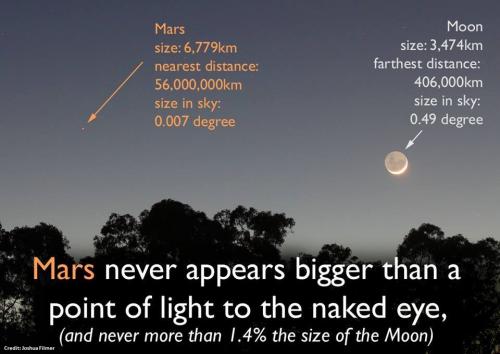 RED SCAM ALERT: Since the 2003 Mars encounter, an internet hoax has been floating around every year that Mars will be as bright as the full Moon. They usually refer to the close encounter described above. This is bunk.
RED SCAM ALERT: Since the 2003 Mars encounter, an internet hoax has been floating around every year that Mars will be as bright as the full Moon. They usually refer to the close encounter described above. This is bunk.
Vanishing Milky Way
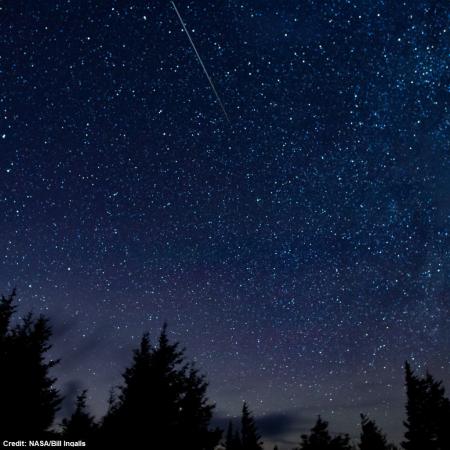 I recently went to Harrington State Park in Wisconsin to watch a meteor shower. The park is on the Lake Michigan shore about 40 miles north of our Planetarium here in downtown Milwaukee.
I recently went to Harrington State Park in Wisconsin to watch a meteor shower. The park is on the Lake Michigan shore about 40 miles north of our Planetarium here in downtown Milwaukee.
It was worth the trip as always. I lay down on a blanket on the beach and enjoyed the darting sparks of tiny rocks burning up in our atmosphere. I counted about 20 meteors in my hour of stargazing. In between the fiery flashes, I searched for the stunning white glow of our Milky Way galaxy. I could barely see it. I think I saw a very faint, subdued glint, if that.
A hundred years ago here, the Milky Way would have shined true to its name -- a vibrant, milky swath stretching across the sky, the combined light of billions of stars in one of the spiral arms of our home galaxy. But we are losing the dark. Light pollution is intruding more and more, forcing people to travel farther and farther to see a spectacular star-filled sky—if they have the means to do so. It is estimated that 80 percent of kids growing up today will never see the gorgeous glow of the Milky Way.
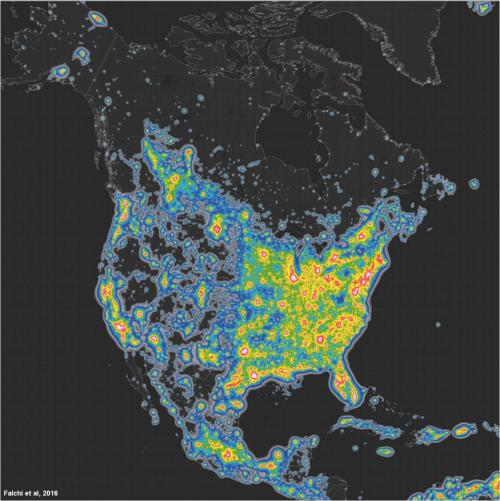 In the image to the right, the black areas are where the natural night sky is still visible. The blue and green represent places of low light pollution, but enough to dim the sky. Sky views in the yellow areas show where the night sky is severely diminished by city lights. There’s not much to see in the red and white areas, maybe a dozen or so bright stars and planets—if you’re lucky.
In the image to the right, the black areas are where the natural night sky is still visible. The blue and green represent places of low light pollution, but enough to dim the sky. Sky views in the yellow areas show where the night sky is severely diminished by city lights. There’s not much to see in the red and white areas, maybe a dozen or so bright stars and planets—if you’re lucky.
While us amateur stargazers can get frustrated with sky glow (the scattering of light in the atmosphere at night), astronomers and astrophysicists also have to find even more remote areas for their telescopes. The venerable Mount Wilson Observatory near Pasadena has been decommissioned. Mount Palomar near San Diego is facing a similar fate if light pollution increases. The best telescopes today are being built in the high altitude of Chile’s Atacama Desert, or in space. Being more distant and isolated, the new observatories are more expensive.
Our lavish nightlights not only disrupt astronomy, but also our ecosystems. Increasing light threatens some nocturnal wildlife. Animal navigation can get thrown off. Predator and prey relations can be interrupted and change nature’s interactions. One example involves algae blooms caused by light pollution preventing zooplankton from eating surface algae and consequently lowering water quality.
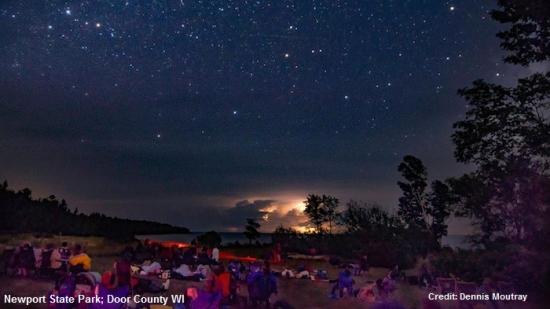 Though it may take a bit more effort, the serious stargazer can still see the Milky Way in Wisconsin. Last year Newport State Park on the northern edge of Door County was designated Wisconsin's first “dark sky” park by the International Dark-Sky Association. Newport is one of 48 parks in the world to receive this stellar label. I wrote a letter of support of making for the park and am very glad the award has come through!
Though it may take a bit more effort, the serious stargazer can still see the Milky Way in Wisconsin. Last year Newport State Park on the northern edge of Door County was designated Wisconsin's first “dark sky” park by the International Dark-Sky Association. Newport is one of 48 parks in the world to receive this stellar label. I wrote a letter of support of making for the park and am very glad the award has come through!
Planetariums preserve the night sky with their amazing and accurate simulations of the night sky. They are essential experiences. Just ask Neil de Grasse Tyson—or read this month’s starting quote. But it’s still so very important to go see the real sky far from city lights and gaze upon the magnificent universe.
Sky Sights
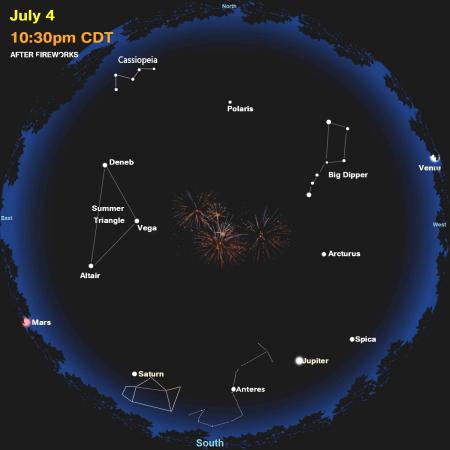
It’s rare to see the four brightest planets across the evening sky, but look right after a fireworks show this early July. Mars will be rising in the southeast shortly before Venus sets in the northwest. Jupiter and Saturn can be seen in between. This planet parade will get easier to see as the red planet rises earlier each night. All four will be visible until Venus slowly leaves the evening in September.
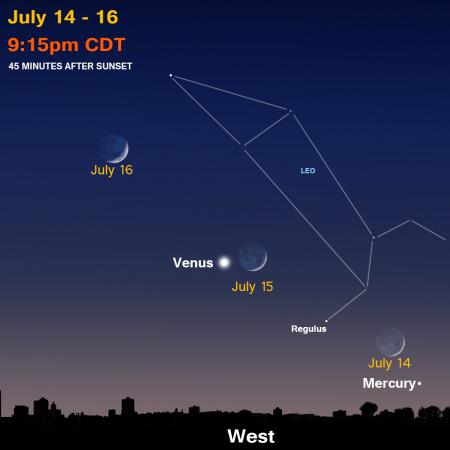
Venus and the Moon make a great pair on July 15. Observe them soon after dusk in the constellation Leo the Lion.
Mercury might be located near a thin sliver Moon on July 14. Fast little Mercury will be very tough to spot.
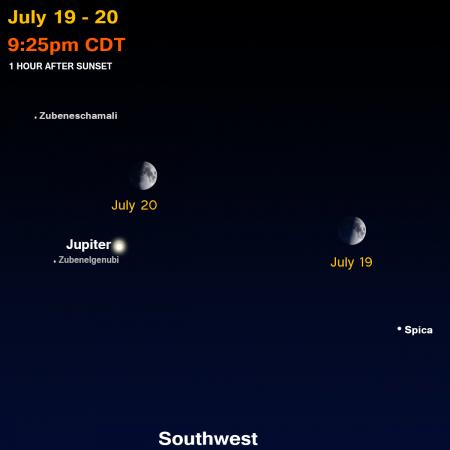
Jupiter moves over a bit to the southwest after sunset. Don’t miss the “Zubee” stars of Libra nearby. The bright Moon joins the group on July 19-20.
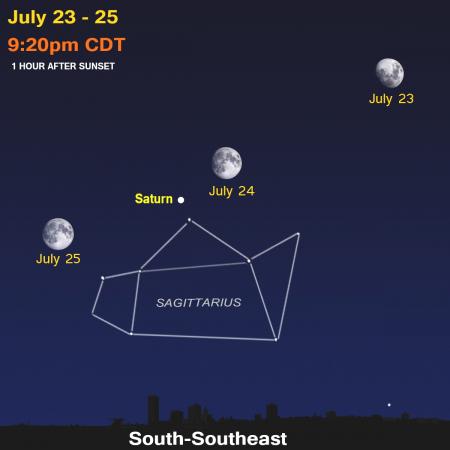
Saturn joins the near full Moon on July 24-25.
Star Map
 Download the July Star Map. >>
Download the July Star Map. >>
Sign Up
Receive this newsletter via email by subscribing here! >>
See the Universe through a telescope! Join one of the Milwaukee-area astronomy clubs and spot craters on the Moon, the rings of Saturn, the moons of Jupiter, and much more.
 Follow Bob on Twitter @MPMPlanetarium
Follow Bob on Twitter @MPMPlanetarium

